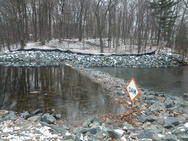|
Volume 10 Issue # 1 January 2019

DNR dam safety engineers held dam owner informational sessions in July 2018. The one-day sessions provided information on a wide range of topics including:
- Dam terminology
- Responsibilities of a dam owner
- Dam permitting
- Inspection and operation of dams
Approximately 30 people attended each session with a large representation of private dam owners and some consultants. These sessions also offered professional development hours for engineers.
Each session featured great discussions and questions. Dam owners provided comments and expertise relating to their specific dam, resulting in conversations that touched on a variety of types of control structures. The sessions also provided an opportunity for dam owners to speak with, and ask questions of, the regional dam safety engineer covering their geographical area. If you have immediate questions, please visit our Dam Safety website, or contact your local dam safety engineer listed on the website.
Follow-up surveys revealed that attendees found the presentations very helpful and 78 percent said they would attend a future session! The team has considered all attendees’ comments and is arranging 2019 sessions to present more in-depth discussions on several topics. If you have a suggestion for a future topic, please send your ideas to DNRDAMSAFETY@wiscosnsin.gov. Keep an eye out for invitations to the 2019 sessions. We hope to see you there!

Have you thought about your dam failing during the winter months? Most people associate dam failures with heavy rains, high flows, and spring/summer months. However, emergency situations may occur at dams at any time. It is important to regularly inspect and monitor your dam, even when covered in snow.
The photo to the left depicts unsafe ice conditions that developed after a winter dam failure.
Here are some examples of situations that may occur during the winter.
- Ice may break loose and block gate operation, cause water build-up behind the dam, or damage the structure upon impact.
- Rapid snow melt may cause increased runoff across frozen ground ultimately reaching your impoundment and causing high water level issues.
- Rodent burrows may cause piping and erosion.
- Freeze/thaw cycles may damage embankments and concrete.
- Ice may cause gates to become frozen and inoperable.
The DNR is currently working on modifying the Emergency Action Plan (EAP) template to include winter emergencies. The current EAP focuses on downstream impacts and emergency response. During the winter, a failure may cause unsafe ice conditions. There may be people on the lake (ice fishing, snowmobiling, etc.) that are unaware of the potential loss of water or ice movement/breakup.
During a winter emergency, upstream impacts also need to be considered, including:
- the locations and owners of public access points and boat launches, as access may need to be restricted;
- notifying residents adjacent to the impoundment of potential unsafe ice conditions;
- evacuating anyone utilizing the lake at the time of the emergency, such as ice fisherman and snowmobilers; and
- preventing ice damage as ice may break free and impact the dam.
Winter is a great time to update your EAP. Contact your regional engineer with any questions.
|
Winter Inspections
 Winter is once again upon us in Wisconsin. Impoundments are or will shortly become ice covered. So there is no need to check on your dam until springtime, right? Wrong. Water works on and against dams every minute of every day all year long, including the cold winter months.
As the owner of a dam, you should still check on your structure even during the winter months to observe its performance. Here are some winter dam inspection tips.
Check for and address debris build-up around the primary control structure year-round. As fall transitions to winter, tree leaves and other organic matter from around the impoundment naturally flow toward the spillway of the dam. A build-up of this material in the spillway can reduce its ability to pass water efficiently. If a build-up of this material freezes in or around the spillway, this has the potential to reduce the hydraulic capacity of the spillway and may lead to overtopping and possibly failure of your dam. Having pike poles, gaff hooks or debris rakes readily accessible to you during your inspections are crucial for clearing debris away from your spillway structures.
Walk the earthen embankments of your dam and look for signs of seepage or instabilities of the earthen slopes. Prior to snow becoming deep, seepage areas are readily visible because the relatively warm seepage water will melt the shallow snow in areas of active seepage. Monitor these areas and flag them as areas of interest during subsequent inspections for changes in size and flow volumes. Report cloudy seepage water to your consultant and regional DNR dam safety engineer as soon as possible. Also report any observed slope instability, such as scarps, slides or areas of excessive settlement.
Check the condition of all spillway components during each inspection. Dam construction by a beaver is likely to occur around inlet structures any time of the year. Dams that have fixed crest spillways or rock-lined channels as a primary control structure are particularly susceptible to beaver dams that may obstruct flow and result in changes to the depth and size of the impoundment. You can find guidelines to help solve nuisance wildlife problems on our Dam Safety website.
Routinely inspect dams with gated spillways to ensure that ice build-up will not interfere with operations of these components should a winter rain event or sudden warm-up with run-off occur. You may want to have a steam cleaner available to keep gates ice-free and operational during the winter months.
Remember, inspections of your dam are just as necessary in the winter as they are during other times of the year.
|
The DNR Dam Safety/Floodplain Management Program is pleased to announce that two regional water management engineers (WMEs) joined our team this fall! Jacob (Jake) Druffner will be based out of the Spooner Service Center and Martin (Marty) Wells will be based out of the La Crosse Service Center.
Regional WMEs are your local contacts for technical questions on dams and floodplain studies. These staff also assist with floodplain management. The map below is a quick and easy way to find your WME. A complete list of the WMEs by county, including telephone numbers, email addresses and mailing addresses is available on the Dam Safety web page.
In the next few months, our program will also post a hiring announcement for a state dam safety engineer. This position will assist the regional engineers, review dam plans and dam failure studies, and assist with developing statewide policy and guidance.
 A Little About Jake
Jake graduated with a B.S. in water resources from the University of Wisconsin – Stevens Point and a M.S. in civil engineering with an environmental engineering focus from the University of Minnesota. During school, Jake interned and/or worked for the Minnesota Department of Natural Resources, the Minnesota Pollution Control Agency, the city of Stillwater, the University of Minnesota's Bioproducts and Biosystems Engineering Department, and Wenck Associates. After graduating, he took a job as a water resources engineer in Woodbury, Minnesota.
Jake grew up on a small hobby farm in western Wisconsin. He also spent many summers in eastern Tanzania, learning about foreign culture and service to others from both a medical and educational perspective. Jake and his family love the outdoors and are looking forward to being in rural Wisconsin!
|
 A Little About Marty
Marty graduated with a B.S. in hydrology in 2015 from the University of Wisconsin – Stevens Point. After graduation, Marty worked in Montana for a year and a half at the Bureau of Land Management as a hydrologic technician. Marty then pursued a M.S. in environmental engineering at the University of Nebraska – Lincoln. His research focused on evaluating the relationship between groundwater nitrate and environmental variables via age-dating tracers and machine learning data analytics. With the completion of his thesis, Marty has joined our team!
Marty loves the outdoors and spends much of his free time hiking, camping, kayaking or biking. He also invests much of the weekends playing and following a variety of sports.
|
|